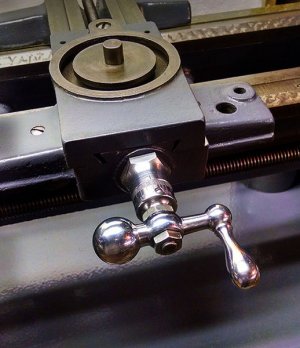
Like a lot of these machines, my crossfeed screw was not the best. It was sort of a good match for a lot of the other things that had been trashed on this poor old thing. The set-screw-to-key-the-handle idea is not really such a good one, it doesn't seem to me. If people do not keep the opposing nuts tight, the things that really lock the handle, the screw takes the load and buggers up the keyway and threads. Mine was gouged all the way around! So too are these the favorite target for any impact that might happen along, and so they are often bent and/or broken.
The threads on the end of mine were quite badly buggered due to the loose nuts crowd. Worse than that was that it was bent pretty severely within the length of the end threads. A significant part of the lash adjustment is taken here, and so a bent screw means extra room needed to keep it from binding as it wobbles. I don't begrudge Logan in getting $200 for a new one, but I just couldn't see it in my budget. I tracked and bought a used screw off ebay that looked quite good. Unfortunately, I traded one set of problems for another. It's a crap shoot, as they are all the same age.
When I began evaluating it, I quickly noted that it was obviously bent. There was noticeable wear from the bronze bushing in LA-254 on the plain portion of the shaft. The end threads were fair; better than mine. The big improvement was that it was not bent withing the threaded area, which is much harder to straighten. It is a tedious affair to build and tear down the feed over and over, trying to get the screw straight. The first attempt proved very beneficial, and I got it to the point that I could not accurately discern the location of the wobble that remained. Still, wobble it did, and so I employed the next strategy.
The first attempt was simply made by eye, and by carefully tapping with a hammer with the screw in the bench vise. For round two, since I could no longer tell exactly where to hit it, I hit it EVERYWHERE. In such instances, I take a soft mallet, in this case rawhide, lay the object on a hard flat surface, and work the entire length and circumference. The soft mallet will not pein of otherwise distort the metal, but any portions that are not touching the hard surface will be bent downward. This tends to drive out any discrepancies that still remain. I was able to get it so that the lash left in the end assemblies is very minimal, to the point of diminishing return, I think. Finish time.
About 45 minutes of detailed filing and strip sanding to get all the nicks and gouges out, and then it was over to the buffing wheel. I'm quite pleased with the results. At some point, it might be nice to replace the bronze busing in La-254, but radial play is far less important than axial in a screw like this. Pending further discovery when it actually makes chips, I'm happy so far.


